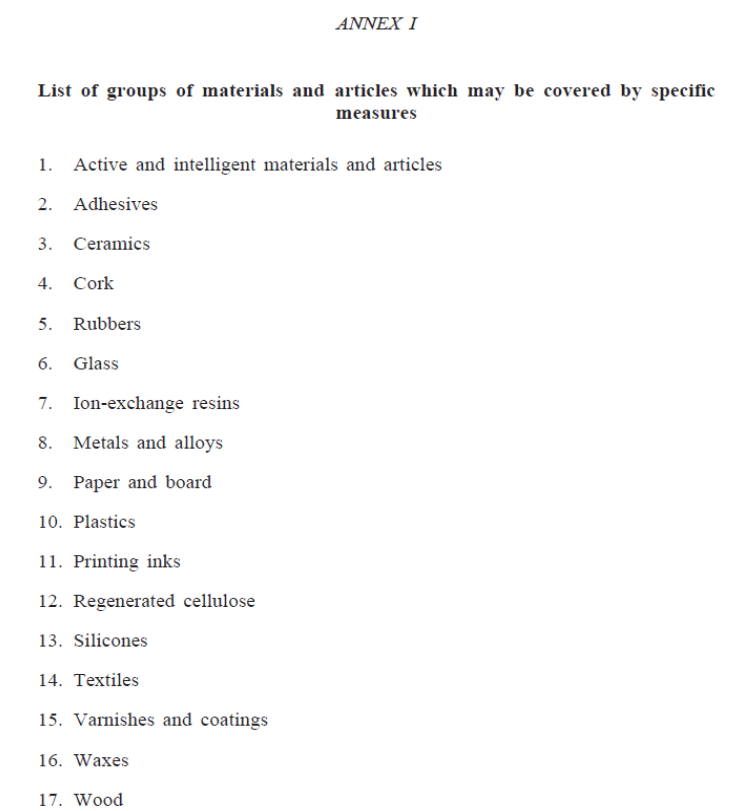
czen
- What are the basic requirements for materials/objects intended to come into contact with food?
Materials and objects must be made in compliance with good manufacturing practice so that under the usual or predictable circumstances of use they do not release their components into food in amounts which may:
a) pose a health risk;
b) cause an unacceptable change in the food contents;
c) cause a deterioration of organoleptic qualities of foods. - In what way am I obliged to declare that materials/objects meet the requirements for contact with food?
By providing a written Declaration of Conformity – a confirmation that these materials and objects comply with relevant regulations. - What is the content of Declaration of Conformity?
Declarations of conformity contain:
a) a list of regulations which are relevant for the given materials/objects,
b) a binding declaration which states that based on carried out tests the given materials and objects meet the requirements of the stated regulations (it is necessary to store the test results themselves and further documentation for the purposes of a potential check by relevant authorities)
c) other specifications of the applied materials/objects. - Where can I find a list of regulations/requirements for materials/objects intended to come into contact with food and further information?
On European Commission websites, section Food Safety, Food Contact Materials (FCM)
https://food.ec.europa.eu/safety/chemical-safety/food-contact-materials_en

- What materials/objects do further special regulations apply to?
They apply to materials/objects stated in Annex I. of Regulation (EC) No 1935/2004 of the European Parliament and of the Council on materials and articles intended to come into contact with food:

- What documentation is required if you want to supply Plzeňský Prazdroj, a.s. and Plzeňský Prazdroj Slovensko, a.s. with materials and objects intended to come into contact with food?
It is necessary to provide the following documentation, already during the selection process:
a) Declaration of Conformity for products and materials intended to come into contact with food. In all cases, it is necessary to declare conformity with:
• Regulation (EC) No 1935/2004 of the European Parliament and of the Council on materials and articles intended to come into contact with food
• Commission Regulation (EC) No 2023/2006 on good manufacturing practice for materials and articles intended to come into contact with food - What is the validity period of the Declaration of Conformity and when does the duty to issue a new Declaration of Conformity arise?
a) The Declaration of Conformity regarding the contact of materials/objects with food is issued by the producer based on the results of tests/expert assessment (migration tests) which are determined by European or national legislation. The validity of the Declaration of Conformity is limitless within the period stated by its issuer.
b) It is necessary to issue a new Declaration if new tests of the material/object (new migration tests) intended to come into contact with food have been done. - When is it necessary to do new Migration tests?
In case that an expert (an independent accredited institution/organisation) has limited the validity period of the assessment/certification and/or the expiration period has passed.
In case that:
-There has been a change in legal requirements – i) the allowed migration limits for the monitored substances have become stricter, ii) testing of other substances present in the material/object was directed, iii) the testing methodology has been changed (e.g. Regulation (EU) No 1245/2020), etc.),
-The producer has changed the contents of their material/objects and it is necessary to test the new components of the material. - What does the term Total Migration Limit mean?
The highest amount of non-volatile substances released into food or food simulants allowed. - What does the term Specific Migration Limit (SML) refer to?
The highest allowed amount of a specific substance released from a material or object into food or food simulants. - What does the term Total Specific Migration Limit (SML) refer to?
The highest allowed total amount of individual substances released into food or food simulants expressed as the overall content of the stated substances. Materials and objects made of plastic must not release amounts succeeding 10 milligrams of their components into food simulants, specifically more 10 milligrams of all components released together per 1 dm2 of the surface which is in contact with food. - What are Food Simulants?
It is a testing medium simulating food; with its behaviour, it imitates the migration from materials for contact with food. A 3% acetic acid and a 20% ethanol are used to simulate contact with beer.